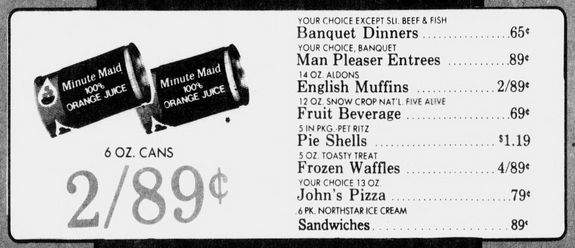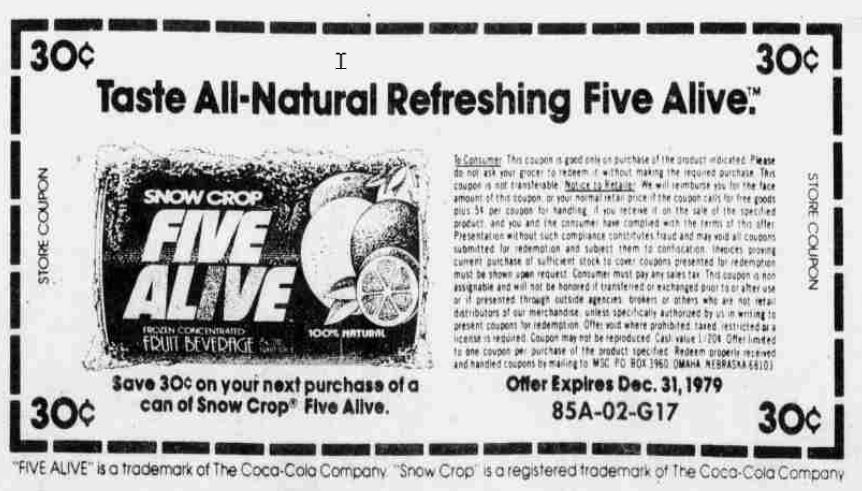What did the 1980s taste like? If we're going to limit ourselves to something available then that you can't get anymore, I would submit Five Alive juice for your consideration. Five Alive was a citrus beverage, containing orange, lemon, grapefruit, tangerine, and lime juice. It was a product of the Minute Maid division of the Coca-Cola Company.
What did Five Alive juice taste like?
![]()
Five Alive was a blend of five citrus juices, popular in the 1980s but discontinued in the 1990s, at least in the United States. Canadians must have liked it better because it still exists there.
The main ingredient in Five Alive was orange juice. So it really tasted like modified orange juice. People who liked orange juice might like Five Alive a little better or a little less. But people who didn't like orange juice much might like Five Alive. Some people described Five Alive as tasting like orange juice with more body or more tart, or less pulp, or slightly tangier.
All three of those match my recollection.
Grocery stores sold Five Alive alongside orange juice in frozen concentrated cans, cartons, and later, juice boxes. You mixed the concentrate in a 3-to-1 ratio just like frozen orange juice concentrate. I've seen references to seven different varieties, all of which were mixtures of five different types of fruit juice. But the one I remember was the original. To me, the original Five Alive tasted like the 80s. It looked like the 80s too. Some of those colors on the packaging turned up in Swatch watches and jam shorts.
Five Alive's time on the market

This snippet of an October 22, 1978 grocery flier from the old Tom-Boy supermarket chain was the earliest mention of Five Alive I found. A 12 oz concentrated can cost 69 cents.
Five Alive was introduced into three test markets in 1978. St. Louis was one of them, with Seattle and Indianapolis being the other two. I found a news story in the January 24, 1980 issue of the St. Louis Post-Dispatch that said Five Alive first sold in St. Louis in September 1979. I think they meant September 1978, because I found coupons and mentions in grocery fliers in the Post-Dispatch for the product starting in October 1978. And I found ads for the product in papers in California, New Mexico, and Texas in the September-October 1979 timeframe. In the writer's defense, it's much easier for me to verify that today than it would have been in 1980.
Pinning down when Coca-Cola discontinued it in the United States is tougher. Advertisements for it basically stopped in 1998. I found a couple of mentions of the product in 1999, but no advertising. When a company discontinues a slow-selling product, they may or may not publicize it, and a newspaper may or may not print anything. The logic makes sense. If nobody cares enough about the product to buy it, why would they read the story?
Do they still make Five Alive juice?
In 2001, Coca-Cola entered into a joint venture with Procter & Gamble with the goal of reviving a few flagging brands. Two brands they mentioned specifically were Five Alive and Pringles. Pringles seem to be doing just fine today, but the effort to revive Five Alive in the United States didn't seem to yield much.
Five Alive is still available in Canada, and some people import Five Alive juice boxes via Amazon. It's not cheap, but if you want a blast of 80s nostalgia, that's one way to get it.
My recollections
I remember we would get Five Alive occasionally when I was a kid, but it wasn't something we had around all the time. I really liked it, but maybe not everyone else did. But I remember it being more expensive than regular orange juice, so that may be why we didn't get it very often. Kroger listed it at $1.05 for a 12oz can in Nov 1983, or $1.69 for a 64oz carton. That works out to $3.22 and $5.19 in 2023 dollars, so my recollection of it being expensive is correct.
Figuring out how the price compared to regular orange juice was tougher, because stores didn't advertise them side-by-side very often. I found a Jan 1982 ad from Schnucks, a grocery chain local to St. Louis, offering a 12oz can of Five Alive concentrate at $1.39, vs Minute Maid orange juice concentrate at $1.19 for a 12oz can. A generic or off-brand orange juice would be cheaper than both of them, but those prices were even less frequently advertised.
When I was in college in the 90s, I discovered that if I didn't want people hassling and pushing alcohol on me, I could get some Five Alive and drink it straight. It looked different enough from straight orange juice that it could pass for a screwdriver.
Criticisms of Five Alive juice
It seems like everyone who says they miss Five Alive juice drink think they're the only one. I liked it. But it wasn't without criticism in the 1980s.
The criticism was that calling Five Alive juice was a misnomer. It was only 60 percent juice. Worse yet, there was no nutritional information on the can. Futhermore, added sugar was the third ingredient on the label, behind orange juice and water but ahead of all four other juices. Coca-Cola said it marketed it as a fruit punch and later as a citrus beverage, not fruit juice. But the packaging looked suspiciously like orange juice. I always figured Five Alive was just a blend of juices until I looked into it.
Is Five Alive good for you?
I imagine one of the reasons we stopped buying Five Alive, besides the price, was because my dad was a doctor. The added sugar would have given him pause, and Dad would have mentioned at some point that regular orange juice is healthier. Since Five Alive was 60% juice, it would in theory have more nutritional value than soda. But if Five Alive had significant nutritional value, Coca-Cola would have had no reason to be cagey about it.
And the nutritional gap between Five Alive and orange juice was an evolving situation. As the 1980s progressed, fortifying regular orange juice with calcium became more common. Even some house brands of orange juice started including calcium. Buying calcium-fortified orange juice over Five Alive was a no-brainer.
Even with regular orange juice, drinking too much of it increases your sugar intake beyond what's healthy. An 8-ounce glass with a meal is fine. Beyond that, following the rule of drinking the same amount of water as you drink other drinks would be advisable with any fruit juice, let alone Five Alive. This is all assuming you're Canadian and can still get Five Alive, of course.
Why Five Alive failed in the United States

This coupon for Five Alive ran starting in October 1978 in the test markets of St. Louis and Indianapolis. It represented a hefty discount of 37 to 43 percent off.
Five Alive wasn't for everyone. But one factor that helped cause Five Alive to fail in the United States was the price. The news article I found from 1980 said that in testing, Five Alive's sales exceeded expectations. But in the first grocery store ad I could find, I noticed 12 ounces of Five Alive concentrate sold for 22 percent less than 12 ounces of Minute Maid orange juice concentrate, which was also a Coca-Cola product. As time went on, in the ads I could find, Coca-Cola and/or the stores who sold it were trying to charge a premium for Five Alive over regular orange juice. Why pay a premium for a frozen concentrate whose second ingredient is water? Since they were already cutting the juice with water, in my mind, it needed to cost a bit less than a product that was 100 percent juice.
But the other thing I noticed is that the advertising and promotion for Five Alive dropped as the 1980s wore on. Maybe the bigger problem wasn't the buying public feeling ripped off or deciding they didn't like it. It could be that the buying public simply needed a periodic reminder that Five Alive still existed.
Between store ads and Coca-Cola's own advertising, I found 104 occurrences of the phrase "Five Alive" in the St. Louis Post-Dispatch during the 1980s. In the 1990s, I would expect at least 20% dropoff since it wasn't available the full decade. Maybe a bit more since St. Louis area grocery stores consolidated a great deal in the 80s and 90, which meant fewer grocery ads. But there were only 21 mentions of Five Alive in the 1990s. And three of those weren't for Five Alive juice drink at all, but rather, of a rock band from Ohio that adopted the name and played the occasional gig in St. Louis.
In my non-expert opinion, Five Alive juice drink died of neglect.
A contemporary alternative to Five Alive
Aldi stores carry a drink called Nature's Nectar that's a blend of six fruit juices: orange, apple, grape, peach, mango, and lemon. It claims to be 100% juice, although the ingredients label makes me question that a bit. It's mostly juice, and it's a higher percentage of juice than Five Alive was. Lime and grapefruit are conspicuously missing, but Five Alive's added sugar arguably made the lime and grapefruit taste more like peach or mango.
My sons like it.
I tried some while I was writing this. It's not quite how I remember Five Alive tasting, but it's also not that far off. It's close enough to make me miss Five Alive less, and I can see why my sons like it. They come by it honestly.
And we only have to drive three miles to get it.